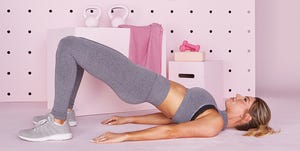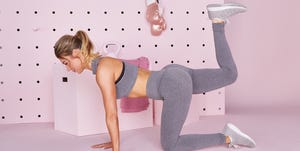The Butt-Sculpting Move That Will Literally Kick Your Ass
Sure, donkey kicks are aptly named since they mimic the animal’s movement—but they also build a great, well, you get the picture. “When performed correctly, this exercise does an excellent job of isolating the biggest and bulkiest glutes muscle—the gluteus maximus,” says Keaton Ray, CSCS, trainer and co-founder of MovementX physical therapy in Portland, Oregon.
In other words: There’s a lot to gain—but only if you can get your form dialed in.
How To Do A Donkey Kick
How to: Get on all fours, with your hands stacked directly under shoulders, and knees under hips. Make sure your back is flat (think: balancing a cup of coffee on your lower back), and tuck your chin slightly so the back of your neck is facing the ceiling. Without rounding your spine, engage your lower abdominals. Keeping the 90-degree bend in your right knee, slowly lift your leg straight back and up toward the ceiling. Your max height is right before your back starts to arch, or your hips begin to rotate. Return to the starting position. Repeat all reps on one side, then switch legs. (Watch Instagram-famous trainer Anna Victoria demo the move above.)
Reps/sets for best results: Aim for two sets of 15 to 20 reps.
Donkey kicks target your glutes, core, and shoulders.
Form tips: Don’t let your lower back arch as your leg lifts, says Ray. This causes you to rely on your back instead of your glutes, which compresses your spine and neglects the muscles you’re aiming for here.
Also, be sure your hips stay level—when your IT band or hip flexors are too tight, your body will compensate by rotating your hips as you lift, Ray says. How to control it: Only lift as high as your hips can stay level (a mirror can help monitor this).
Benefits Of Donkey Kick
Donkey kicks are great for both stability and toning, Ray says. They target your gluteus maximus—the largest of your three glutes muscles, and the bulk of your booty. They also work your core and shoulder muscles, since your entire body has to remain stable while your leg lifts.
This exercise is especially beneficial for anyone who has a desk job. “It helps stretch the hip in the opposite direction that we hold it when we sit,” Ray says, plus the movement counteracts those sedentary hours in a chair. “Both of these things will help to improve posture and prevent hip and spine injuries.”
Make Donkey Kicks Part Of Your Workout
Ray advises incorporating glute-strengthening moves, like the donkey kick, five times per week—whether it’s at the gym or not.



When you’re at the gym, donkey kicks are super-versatile. Because they’re a low-weight move and don’t max out your muscle capacity, they can be a great warmup or part of an active recovery day. If you include them in a leg and butt workout, pair the kicks with butt moves that target the other two glutes muscles—side-lying leg lifts, clamshells, band walks, or single-leg bridges.
If you don’t feel the burn from two sets of 20 reps, add resistance: Try ankle weights, a dumbbell nestled in your knee crease, or a resistance band looped around your lifted foot.
Source: Read Full Article
